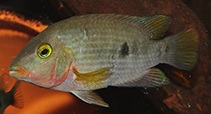| Family: |
Cichlidae (Cichlids), subfamily: Cichlinae |
| Max. size: |
13.68 cm SL (male/unsexed) |
| Environment: |
benthopelagic; freshwater |
| Distribution: |
South America: known only from Argentinean territory in the tributaries of the río Uruguay below the Salto Moconá, province of Misiones. |
| Diagnosis: |
Dorsal spines (total): 15-17; Dorsal soft rays (total): 9-11; Anal spines: 5-6; Anal soft rays: 7-9; Vertebrae: 26-27. This species is distinguished from all Australoheros species except A. forquilha by the following characters: presence of a series of opalescent pale blue dots along the postero-lateral border of the suborbital series (dark markings in preserved specimens); with checkerboard-spotted dorsal, anal and caudal fins (red spots in live animals and dark grey in preserved specimens); a red to orange branchiostegal membrane, mouth and lower head area and base of pectoral fin; by having comparatively thick lips (shared also with A. tembe); with lower jaw shorter than the upper; E0 scales 25–26 (vs. less than 25); with the longest dorsal fin scale cover (shared also with A. tembe); by having the narrowest head, < 50% head width of HL (vs. more than 50%), shortest interorbital, 10.9% of SL and longest preorbital, 9.3% of SL distances. This species differs from A. forquilha by the absence of the opalescent pale blue dots on each body scale, by not having them widely distributed on the head, but limited to a single line below the suborbital series; in having a red coloration limited to the head region and the base of the pectoral fin (vs. red coloration on the whole belly to the end of the anal fin); by having lower counts of caudal vertebrae 13-14 (vs. 14-15), less caudal peduncle vertebrae, modally 2 (vs. 3), lower total dorsal fin counts 25-26 (vs. 26-27) and E0 scales 25 (vs. 26). It is distinguished from the only other similar species, Australoheros tembe, by the above listed unique characters and by coloration (shared only with A. forquilha) and additionally by a shorter caudal peduncle (including 2 vs. 3 vertebrae) and more dorsal fin rays 10-11 (vs. 9) (Ref. 87600). |
| Biology: |
|
| IUCN Red List Status: |
Vulnerable (VU); Date assessed: 20 November 2020 (B1ab(iii)+2ab(iii)) Ref. (130435)
|
| Threat to humans: |
harmless |
Source and more info: www.fishbase.org. For personal, classroom, and other internal use only. Not for publication.
